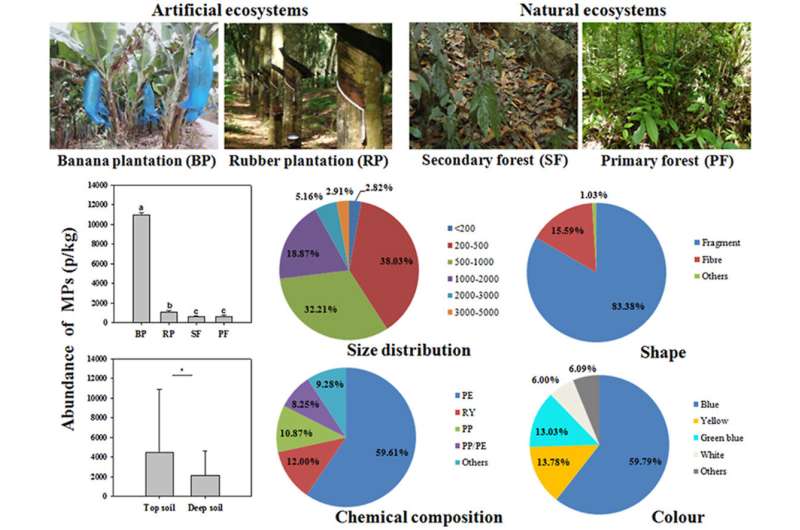Microplastics are widespread in soils of tropical areas

Microplastics (MPs) refer to plastic particles <5 mm in size. Environmental risks caused by MPs are increasing. As fundamental resources of the global food security system, soils are also affected by MP pollution. However, the distribution characteristics of MPs across different land uses in tropical areas remain largely unknown.
In a study published in Chemosphere, researchers from the Xishuangbanna Tropical Botanical Garden (XTBG) of the Chinese Academy of Sciences revealed the widespread presence of soil microplastics in tropical areas, from artificial ecosystems to natural ecosystems, in both the top and deep soil layers.
The researchers chose two natural ecosystems (primary and secondary forests) and two artificial ecosystems (rubber and banana plantations) in the Xishuangbanna tropical region as the study areas. They measured the abundance, size, type, shape, and color of MPs in the upper (0–10 cm) and lower (10–20 cm) layers of the soil.
They found that the dominant size of soil microplastics was <1 mm and the major shapes were fragments and fibers, with colors blue, yellow, and green-blue. Most microplastics were polyethylene, rayon, and polypropylene.
The abundance of microplastics in the top soil layer (0–10 cm) was significantly higher than that in the deep soil layers (10–20 cm). Therefore, MP pollution may be increasing seriously in the top soil in tropical areas.
Furthermore, the effect of land use on the occurrence and characteristics of microplastics was much higher than soil depth and their interactive effects. The abundance of MPs in banana plantations was approximately 10 times that of in rubber plantations, and 18 times of those in secondary forests and primary forests.
In additon, the size of microplastics in the top soil layer in the secondary forest was larger than that in the banana plantations and primary forests, while no size difference was detected among the four land-use types in the deep soil layer.
The study suggested that microplastics pollution has already been an emerging problem across all major land uses in tropical areas.
"MP pollution in artificial ecosystems is more serious than that in natural ecosystems. We call for effective measures and policies to control MP pollution in tropical areas," said Dr. Xu Guorui of XTBG.
More information: Guorui Xu et al, Soil microplastic pollution under different land uses in tropics, southwestern China, Chemosphere (2021). DOI: 10.1016/j.chemosphere.2021.133176
Journal information: Chemosphere
Provided by Chinese Academy of Sciences

















